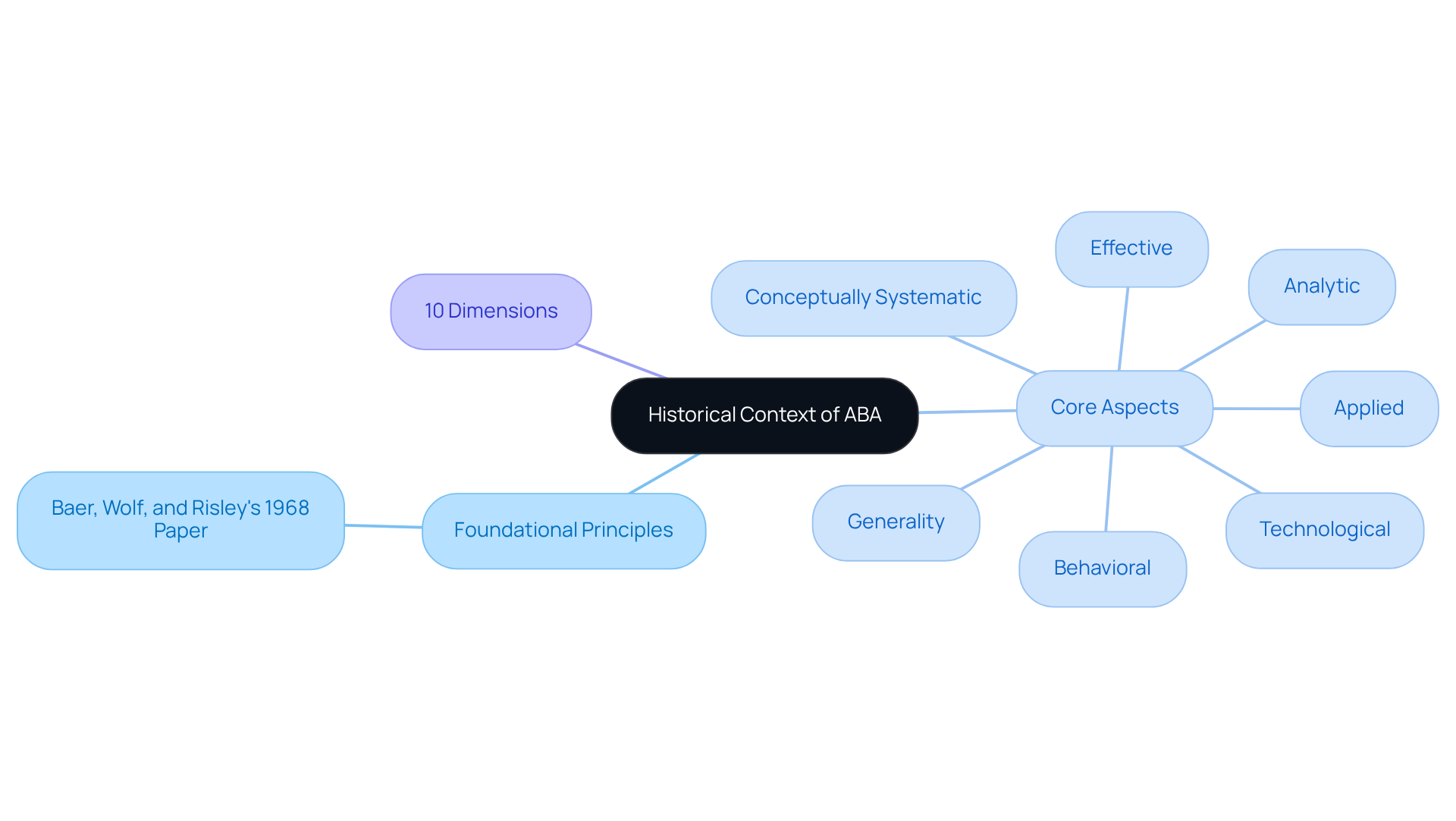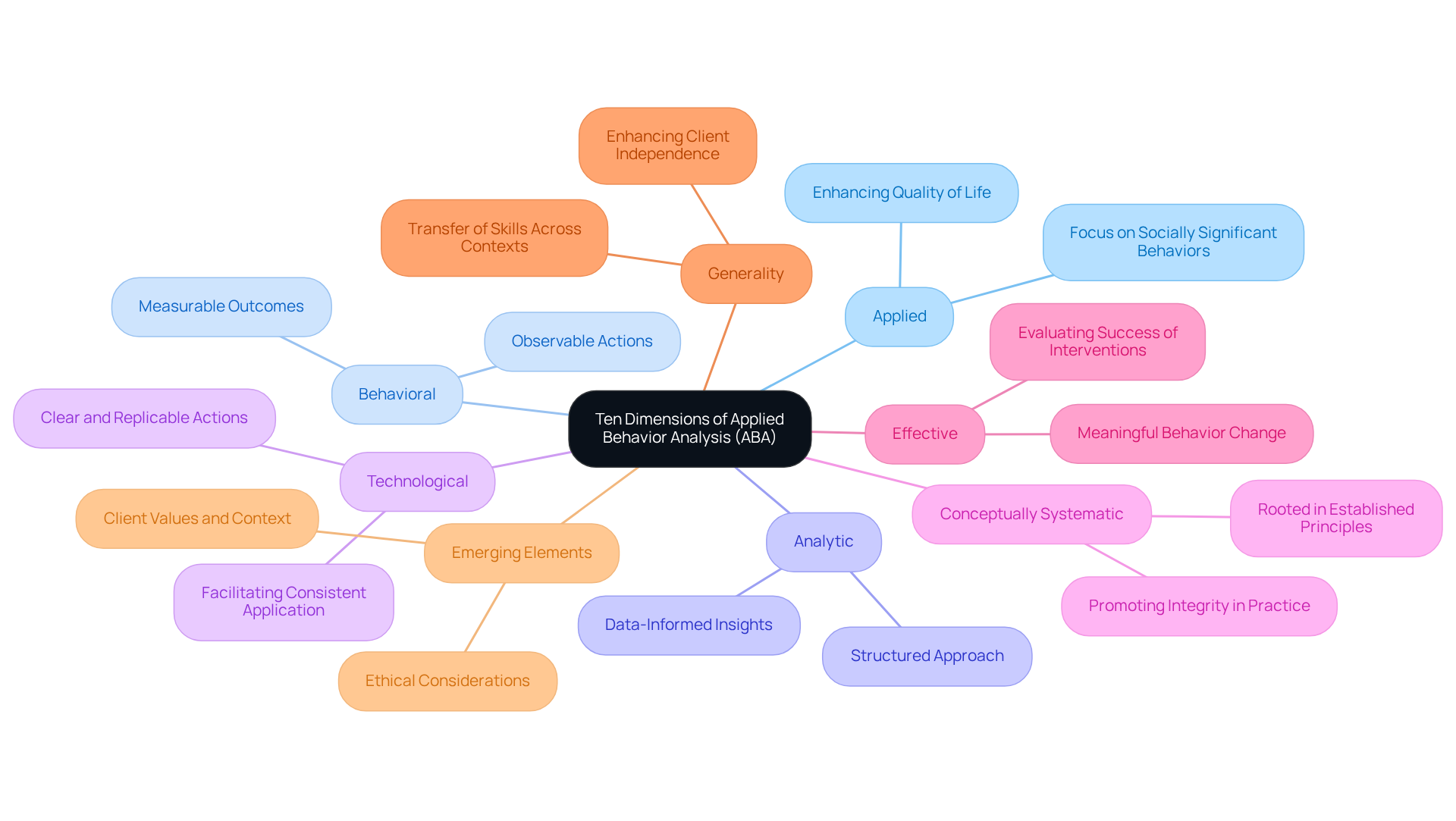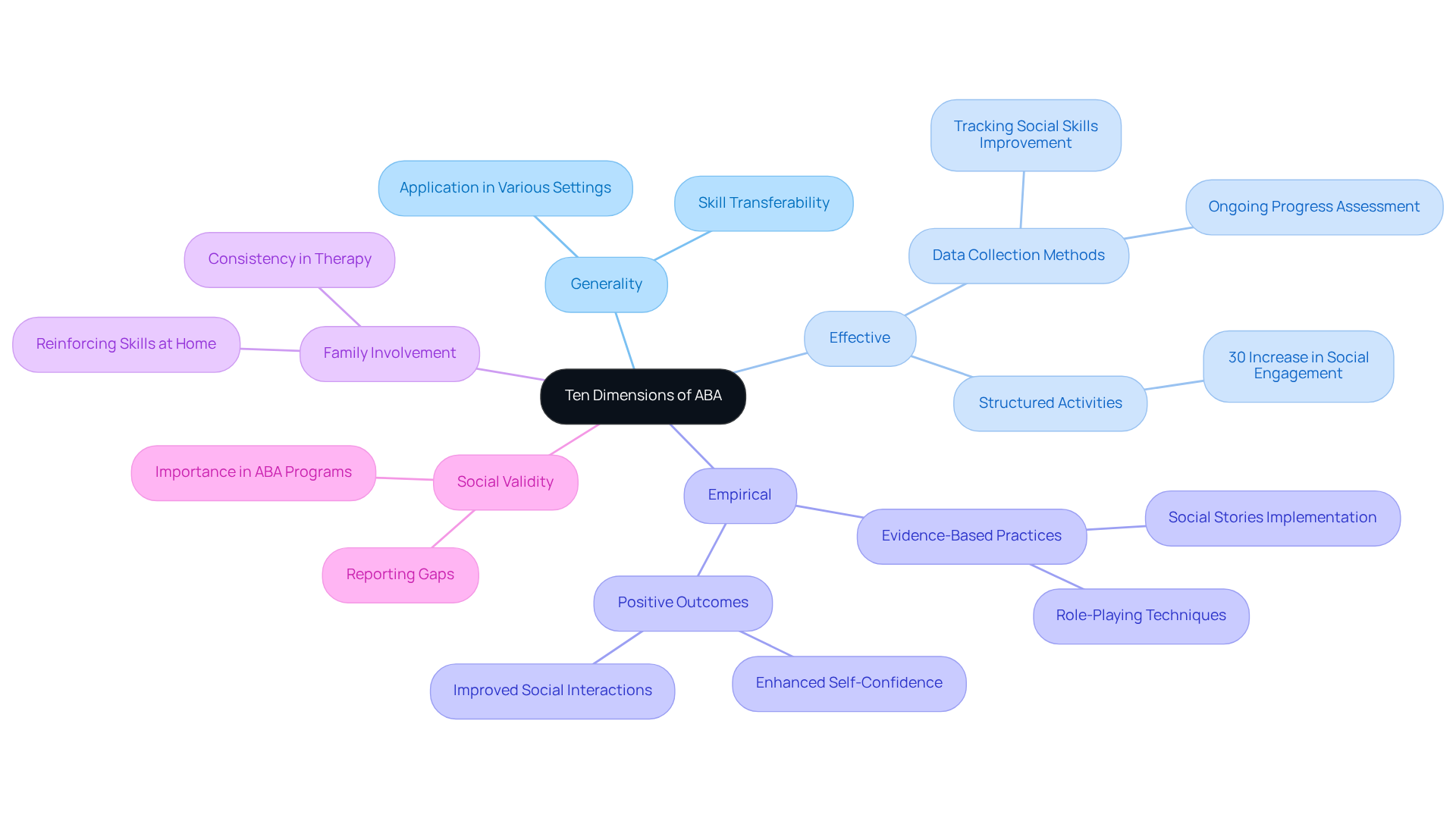September 22, 2025

The article centers on the ten dimensions of Applied Behavior Analysis (ABA), which are crucial for guiding practitioners in delivering effective and ethical interventions. Understanding these dimensions—such as generality, effectiveness, and technological aspects—empowers behavior analysts to develop tailored, evidence-based treatment plans. This approach leads to meaningful improvements in clients' lives, supported by real-world examples and foundational research in the field.
As the demand for Board Certified Behavior Analysts (BCBAs) continues to rise, the significance of these dimensions becomes even more pronounced. By leveraging this knowledge, practitioners can ensure their interventions are not only effective but also ethically sound, ultimately enhancing the quality of care provided.
Understanding the dimensions of Applied Behavior Analysis (ABA) is crucial for practitioners aiming to deliver effective and ethical interventions. These dimensions serve as foundational principles that guide behavior analysts in creating tailored strategies that address the unique needs of clients, ultimately enhancing their quality of life.
However, with so many aspects to consider, how can professionals ensure they are effectively applying these dimensions in practice to achieve meaningful change?
In the realm of Applied Behavior Analysis (ABA), aspects refer to the fundamental characteristics that define the practice and ensure its effectiveness. These parameters serve as guiding principles for practitioners, assisting them in implementing interventions that are not only effective but also ethical and scientifically based. Grasping these aspects is essential for analysts as they navigate the intricacies of therapy and aim to attain significant results for their clients.
Understanding what are the 10 dimensions of ABA, including generality, effectiveness, technological, applied, conceptually systematic, analytic, and behavioral, is crucial for guiding practitioners in their work. For instance, the aspect of generality underscores that actions must endure across various settings and throughout time, which is vital for ensuring that skills acquired in therapy apply to real-life contexts.
The significance of these aspects cannot be overstated; they assist practitioners in navigating the complexities of therapy by understanding what are the 10 dimensions and striving for impactful results for their clients. The practical aspect emphasizes socially important actions, ensuring that strategies address concerns that affect the client's everyday life, such as enhancing communication abilities or decreasing challenging behaviors. As Karina Sharma, RBT, BCBA, states, "The action of interest chosen to focus on in an ABA intervention must be observable and measurable."
Expert opinions affirm that adhering to these aspects enhances the integrity of therapy plans. By integrating the seven aspects into their practice, behavior analysts can develop tailored treatment plans that are evidence-based and adaptable, while exploring concepts such as what are the 10 dimensions. This structured approach not only maximizes the positive impact of therapy on individuals with autism but also fosters enduring behavioral improvements.
Real-world examples illustrate the effectiveness of these aspects in practice. For example, a child taught to use verbal communication rather than physical gestures to request a snack exemplifies the emphasis on observable and measurable changes in behavior. Additionally, the systematic collection and analysis of data are vital in monitoring progress and ensuring that interventions remain effective. Such practical applications underscore the importance of these aspects in achieving successful outcomes in ABA therapy. The Journal of Applied Behavioral Analysis (JABA) serves as a primary source of information for practitioners, reinforcing the credibility of the methodologies employed in ABA.

The foundational principles of Applied Behavior Analysis (ABA) were first articulated by Donald M. Baer, Montrose M. Wolf, and Todd R. Risley in their seminal 1968 paper, 'Some Current Aspects of Applied Behavior Analysis.' This pivotal publication laid down a systematic framework for the field, underscoring the necessity for measures that are both scientifically valid and socially significant.
The seven core aspects of ABA—Applied, Behavioral, Analytic, Technological, Conceptually Systematic, Effective, and Generality—help explain what are the 10 dimensions that provide a structured method for developing successful strategies. The introduction of these dimensions marked a transformative shift in the practice of behavior analysis, ensuring that therapeutic approaches are not only effective but also tailored to meet the genuine needs of clients.
Since that time, the evolution of ABA practices has increasingly emphasized data-driven decision-making and the integration of technology, which have significantly enhanced the effectiveness and breadth of ABA strategies. As Baer, Wolf, and Risley noted, 'Change that endures over time manifests in settings apart from the context in which it was taught and/or extends to other actions not addressed by the intervention.'
This foundational work continues to shape contemporary practices, reinforcing the importance of a structured, ethical approach to behavior analysis that prioritizes meaningful outcomes for individuals and communities.

What are the 10 dimensions of Applied Behavior Analysis (ABA), which encompass Applied, Behavioral, Analytic, Technological, Conceptually Systematic, Effective, Generality, and other emerging elements relevant to contemporary practice? Each aspect is crucial for tailoring approaches that meet the unique needs of clients.
Foundational ABA researchers Donald Beare, Todd Risley, and Montrose Wolf articulated these aspects, emphasizing their critical role in fostering meaningful change. Understanding these components empowers professionals to devise strategies that not only yield effective results but also resonate deeply in the lives of those they serve, ultimately leading to significant improvements in daily functioning. Ethical considerations are also paramount in ABA practice, as outlined in the Ethics Code for Behavior Analysts, ensuring that interventions are both ethical and effective. For example, guiding a child to use a rubber chew stick instead of biting their hands exemplifies the practical application of these principles in therapy. The acronym 'GET A CAB' serves as a valuable mnemonic for recalling these measurements, underscoring their importance in practice.

Real-world applications of the ten aspects in Applied Behavior Analysis (ABA) are prominently evident across diverse interventions, especially within educational environments. Consider the 'Generality' aspect: behavior analysts ensure that skills acquired during therapy seamlessly transfer to various settings, such as home and school. Research reveals a notable gap in the reporting of social validity in ABA programs, underlining the critical nature of skill transferability across different environments. Moreover, family involvement in ABA therapy fosters consistency in reinforcing skills learned, thereby enhancing overall effectiveness.
The 'Effective' dimension is exemplified through rigorous data collection methods that meticulously track improvements in a child's social skills over time. For instance, a study involving 100 boys aged 4 to 11 demonstrated that structured activities led to a remarkable 30% increase in social engagement during peer interactions. This data-driven approach not only highlights the efficacy of the strategies employed but also empowers practitioners to make informed decisions regarding treatment plans, emphasizing the importance of ongoing progress assessment.
Additionally, successful ABA interventions in schools frequently incorporate the 'Empirical' aspect, where evidence-based practices are applied to tackle specific behavioral challenges. Techniques such as role-playing and the implementation of Social Stories have proven effective in assisting children to navigate social scenarios, thereby alleviating anxiety and promoting meaningful interactions. Effective ABA practices significantly bolster self-confidence in children with autism, further exemplifying the positive outcomes associated with these evidence-based strategies. Practitioners can markedly enhance the overall effectiveness of ABA therapy by integrating what are the 10 dimensions into their therapeutic practices, resulting in improved outcomes for their clients.

Understanding the ten dimensions of Applied Behavior Analysis (ABA) is paramount for practitioners aiming to deliver effective and ethical interventions. These dimensions serve as foundational principles that guide behavior analysts in their practice, ensuring that therapeutic strategies are both scientifically valid and socially significant. By mastering these aspects, practitioners can enhance the quality of their interventions, leading to meaningful improvements in the lives of their clients.
Key insights throughout this discussion emphasize the importance of each dimension:
Each aspect plays a critical role in shaping interventions tailored to meet the unique needs of individuals, fostering an environment where skills can be transferred and maintained across various settings. Real-world applications further illustrate how these dimensions can lead to successful outcomes, reinforcing the significance of a structured approach to behavior modification.
Ultimately, embracing the ten dimensions of ABA elevates the practice of behavior analysis and underscores a commitment to ethical standards and meaningful client outcomes. As the field continues to evolve, staying informed about these dimensions empowers practitioners to implement data-driven, effective strategies that resonate with the individuals they serve. This commitment to understanding and applying the dimensions effectively can transform lives, making a profound impact in the realm of behavior analysis.
What are the dimensions of Applied Behavior Analysis (ABA)?
The dimensions of ABA include generality, effectiveness, technological, applied, conceptually systematic, analytic, and behavioral. Understanding these dimensions is crucial for practitioners to implement effective and ethical interventions.
Why are the dimensions of ABA important?
The dimensions guide practitioners in navigating the complexities of therapy, ensuring that interventions are effective, ethical, and scientifically based. They help achieve significant results for clients by focusing on observable and measurable behaviors.
What does the dimension of generality refer to in ABA?
Generality refers to the need for behaviors learned in therapy to endure across various settings and over time, ensuring that skills are applicable to real-life contexts.
How do the dimensions of ABA assist in creating treatment plans?
By adhering to the dimensions, behavior analysts can develop tailored, evidence-based, and adaptable treatment plans that maximize the positive impact of therapy on individuals, particularly those with autism.
Can you provide an example of how the dimensions of ABA are applied in practice?
An example is a child being taught to use verbal communication instead of physical gestures to request a snack, which illustrates the emphasis on observable and measurable behavior changes.
What role does data collection play in ABA?
Systematic collection and analysis of data are vital for monitoring progress and ensuring that interventions remain effective, highlighting the importance of the dimensions in achieving successful outcomes.
Where can practitioners find reliable information on ABA methodologies?
The Journal of Applied Behavioral Analysis (JABA) serves as a primary source of information, reinforcing the credibility of the methodologies employed in ABA.
Our expert recruitment strategies and AI-driven sourcing ensure that you receive top-notch candidates quickly, without compromising on quality. Whether you’re looking for BCBAs, Clinical Directors, or RBTs, we’ve got you covered.